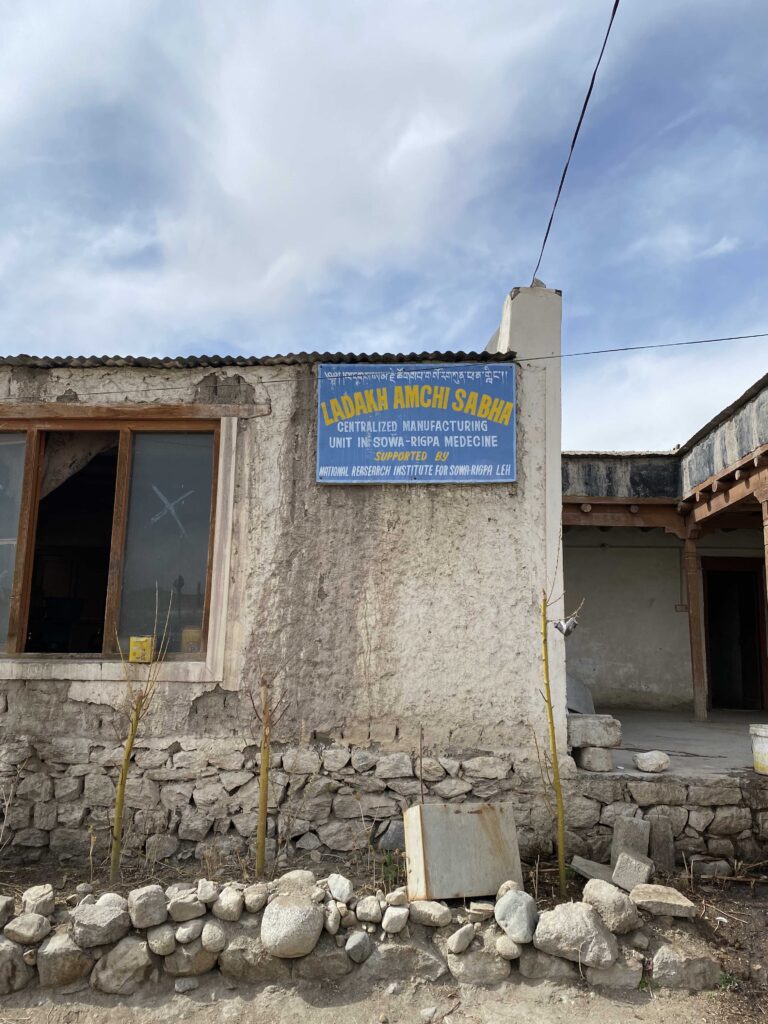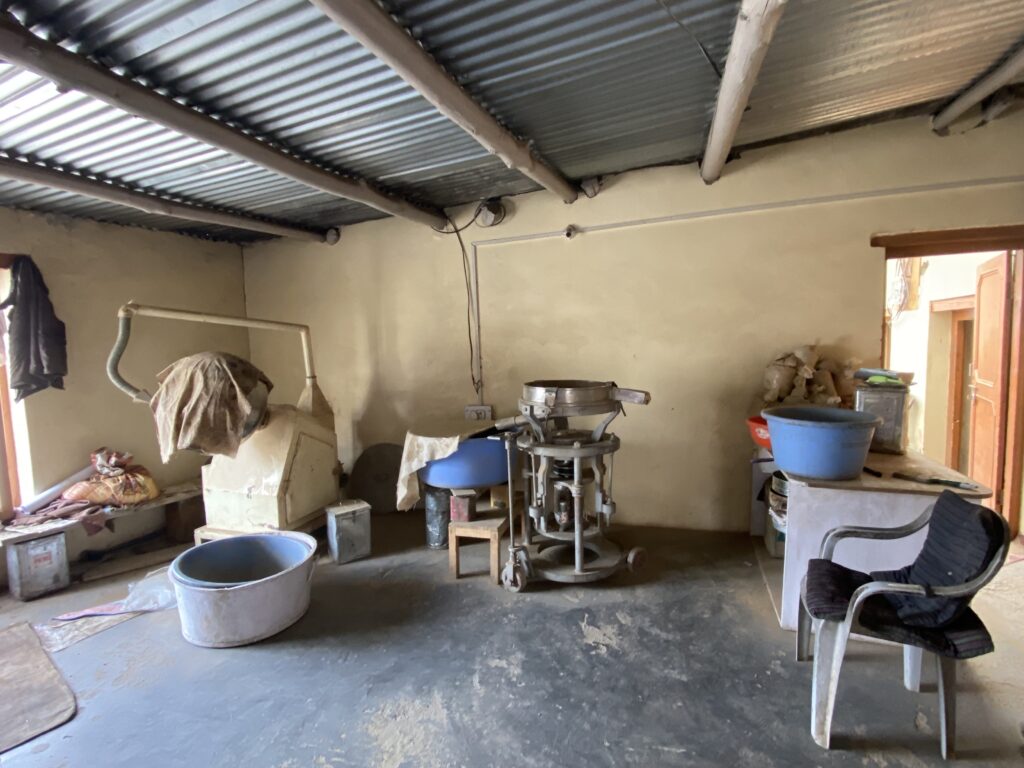The Ladakhi Amchi or traditional Ladakhi doctors are not just doctors who cure patients but are an intricate part of the Ladakhi culture that is now seeing tides of change.

I got an opportunity to visit one of the largest Amchi hospital in Leh – the Skalzangling Ladakh Amchi hospital, and although I wasn’t very excited for the meeting initially, as conversations steamed over a cup of hot tea and biscuits on a cold March afternoon, I thanked my lucky stars for having me there! I was there with three other girls from Sweden, all with different backgrounds, which added a lot of perspective to this discussion, albeit informal and candid.




We met with one of the Amchis who practices there, and the manager of the place. What amazes me so much about any such place I visit is the gentle and sweet nature of the Ladakhis. The way they welcome everyone to their culture is nothing short of overwhelming, and this was just another such experience for me.
This was a very raw introduction to the life of a Ladakhi. The side of Ladakh that believes in herbs and nature as a healer of all physical and mental pressures of life, with a pinch of astrology! Yes!! Apparently, all Amchis are trained in basic astrology which they use but seldom only. But with the growing influx of western medicine in the societies and communities in Leh and Ladakh region, the latter wins in preference these days. Is this a concerning issue for the people here and the region at large??

Even a cursory glance at some research papers and reports would be enough to point at the importance and relevance of traditional knowledge in our lives. As a safeguard against the ills to human health, well-being, and the ever-mounting challenges of the climate crisis. The disruption of thought that the indigenous knowledge holds is not based on scalability and expansion, but roots in efficacy and ecological balance not just with the region and geography, but with the seasons and more. These are critical for saving parts of us, to save the whole of us. Climate change is a global challenge that can only be paused or better, reversed, from the ground up. While accounting for human health, I recall a short conversation I had with Mia who is a veterinary doctor, one of the three Swedish girls I met with for a brief period, where she explained to me how animal health is so important to human health and how we can actually prevent a lot of diseases that jump from animals to humans by being kind and careful of the well-being of our animals! The integration of all this is so fascinating, of course, it not easy. But really, if we just preserve what we already have, the knowledge that has existed since the birth of humankind and the wonderous Earth that we have been able to unlock, come what may, our arsenal is well equipped.
The Amchi told us that most people who come to them have problems related to pain in the back and knees, which is also because most people who visit them are older people. The younger generation is more attracted to contemporary hospitals and the new age medicine which comes with instant or quicker relief than the prescriptions of the Amchi, which usually takes a couple of days to ten days to really cure. But there are several testimonials that vouch for the effectiveness of traditional medicines to cure the disease from the root cause – as against the modern medicines that do not really guarantee permanent cure in most cases. Be it common flu, or some major disease, the Amchi has a cure in the concoction of herbs that they make themselves. Unless it is a disease like cancer, a Ladakhi would not go to a modern hospital.
The Amchi is not just the doctor who sits and prescribes a potion to the patients, they also forage the herbs and flowers from the rough and barren moonscape mountains of Ladakh- treks that last days, and then come back and supervise the making of the medicines. No wonder the Amchi doctors have the perfect knowledge of the natural growth and functioning of the region, and the enormous ocean of knowledge they hold on natural resource management as well. Their job ties the ecological, environmental, human and animal, and social elements seamlessly with one another. The recent IPCC report released on 28th February 2022 also recommends preserving and continuing the practice of age-old knowledge of the indigenous people because they are highly experienced and offer the most region-specific solutions to the challenges faced by the region. Also, pointing out the cause and changes in the natural environment is much easier for the locals with such knowledge than for others, alien to the land.
These herbs and flowers are often found in harsh mountains that are difficult to trek in the pristine mountains of Khardungla and others. Despite being harsh, these places are thoroughly visited by travellers on their personal or group vehicles and face the brunt of brutal tourism. The Amchi told us that because of the increasing pollution in these areas, they are not able to fetch many herbs, or in the quantities required these days. Thus, they are now resorting to constructing greenhouses and plantations for cultivating the herbs on lower lands, under their strict supervision. But the effectiveness of the herbs does not match the ones obtained on the high mountains.
Being an Amchi is a profession of much repute. Passed on through generations, the knowledge remains well sealed and the occupation also passes down the family tree effortlessly, with the sons of the Amchi doctors being trained in the profession from a very tender age. Girls are generally not the amchi doctors, and the profession is highly male-dominant. However, these days, there are different ways in which one can train themselves. They have to undergo formal education at a college that teaches them the traits of the trade and anyone can train to be one.
Following the intense discussion on the changing world of the Amchi’s, we were taken to the medicine manufacturing unit where we found sacks of herbs nicely kept in the store room and smelling spectacular. Inside were ladies and men working synchronously like a chime while the processed medicines sunbathed at the other end of the room. Each pellet or sprinkle of these medicines is truly handmade with love.
We are slowly moving towards a blurry difference between the rural and the urban, with tourism being one of the major causal factors for this. And in places like Leh and other regions of Ladakh, this difference can be observed to fade at a much faster pace than the rest. It is primal to understand that for the preservation of the local Amchi doctors, not just the locals or the people working in the hospitals need to work, but the local government needs to look in all directions to understand the complexity of the challenge. And the visitors need to take responsibility and be more aware and respectful of the place they are visiting.


Great insight into one of the many forms of Alternative Medicines available in India. While I am skeptical about some, there are many which definitely suit the ecological niche in which they operate or benefit. Experiencing something like this first hand is also one of a kind experience. Kudos!
Thankyou bhaiya! Very true, the ecological linkages to our traditional lifestyle is immense. And this is just one of them. So happy you liked this piece. 🙂